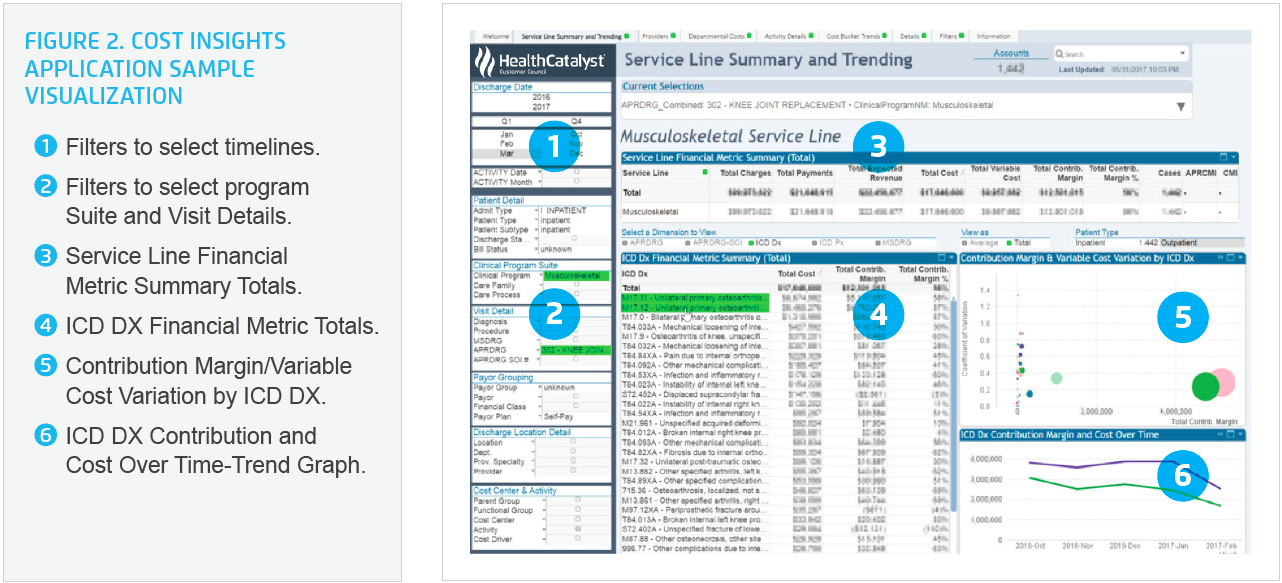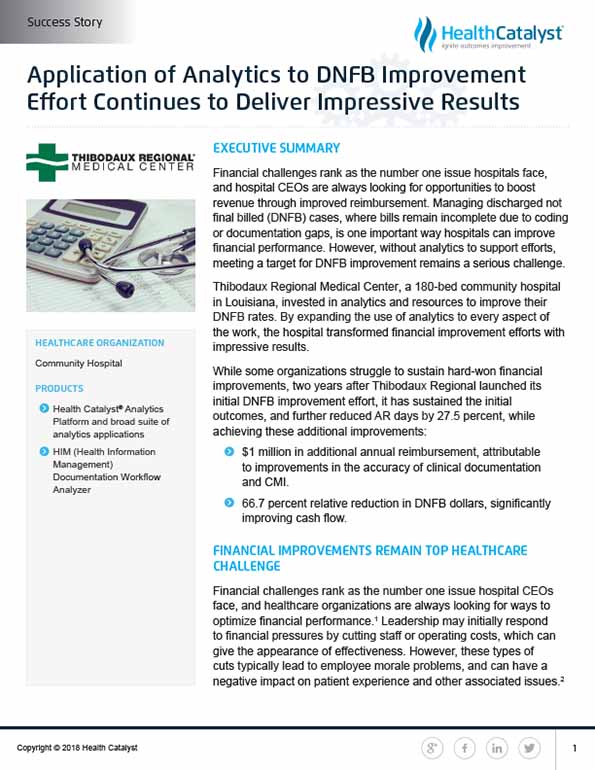Financial challenges rank as the number one issue hospitals face. As a result, these organizations are constantly looking for strategies to improve outcomes, manage costs, and boost revenue. Learn how Thibodaux Regional Medical Center sustained and improved its discharged not final billed (DNFB) efforts.
Financial challenges rank as the number one issue hospitals face, and hospital CEOs are always looking for opportunities to boost revenue through improved reimbursement. Managing discharged not final billed (DNFB) cases, where bills remain incomplete due to coding or documentation gaps, is one important way hospitals can improve financial performance. However, without analytics to support efforts, meeting a target for DNFB improvement remains a serious challenge.
Thibodaux Regional Medical Center, a 180-bed community hospital in Louisiana, invested in analytics and resources to improve their DNFB rates. By expanding the use of analytics to every aspect of the work, the hospital transformed financial improvement efforts with impressive results.
While some organizations struggle to sustain hard-won financial improvements, two years after Thibodaux Regional launched its initial DNFB improvement effort, it has sustained the initial outcomes, and further reduced AR days by 27.5 percent.
Financial challenges rank as the number one issue hospital CEOs face, and healthcare organizations are always looking for ways to optimize financial performance.1 Leadership may initially respond to financial pressures by cutting staff or operating costs, which can give the appearance of effectiveness. However, these types of cuts typically lead to employee morale problems, and can have a negative impact on patient experience and other associated issues.2
Finding a more sustainable approach requires analyzing opportunities to find those most likely to deliver improved financial performance and then focusing efforts on those targeted areas. Improving clinical documentation to accurately reflect the severity of the medical condition is one strategy that helps hospitals achieve a higher level of appropriate reimbursement.2 Strategies such as improving accuracy of documentation and accurate case-mix index (CMI), reducing the number of billhold accounts outstanding, reducing AR days, and managing DNFB cases, where bills remain incomplete due to coding or documentation gaps, are all important ways that healthcare organizations can improve financial performance. However, with competing priorities for resources, and without analytics to support efforts, targeted improvement in these areas can lag behind benchmarks.
Thibodaux Regional invested in analytics and resources to improve their DNFB cases, seeing excellent initial results, including decreasing the number of billhold accounts by 70.5 percent, and an 8.2-day reduction in AR days.
When healthcare organizations invest a lot of time and resources to improve quality and performance with positive result, the goal is always to sustain those improvements. However, without ensuring built-in accountability and visibility—and without continued monitoring of the issue—results often slip away over time, putting improvement efforts back where they started.
Thibodaux Regional’s leadership wanted to ensure their investment of time and resources paid off, and the improvements they worked so hard to achieve were sustained.
Thibodaux Regional implemented the Health Catalyst® Analytics Platform, and was able to leverage the clinical, financial, operation, claims, and other data aggregated in the analytics platform by deploying a DNFB analytics application on top of the analytics platform. This application, and the HIM (Health Information Management) Documentation Workflow Analyzer, eliminated the manual processes and integrated DNFB data into the hospital’s dashboard and workflow (see Figure 1).
The analytics applications enabled quick and easy access to the information Thibodaux Regional needed to effectively manage its efforts, leading to improvements in physician documentation, a reduction in the number of billhold accounts outstanding and AR days, and a more efficient workflow process for both coders and physicians.

Thibodaux Regional continued to optimize and monitor patterns and trends in its DNFB processes, AR days, and workflow procedures. In addition, the analysis of accurate coding and documentation and the impact on CMI led to interventions that improved the accuracy of clinical documentation, ensuring appropriate reimbursement for the level of care provided.
Leadership at Thibodaux Regional worked with physicians to ensure documentation more accurately reflected a patient’s condition. With targeted data, it is clear where issues are occurring. For example, the CMS Pepper report showed the hospital was lower than the national average for surgical capture rate related to patient co-morbidities. Thibodaux Regional used the Cost Explorer Application to review the clinical documentation for the surgery patients, and narrow down whether the patients had comorbidities. If they did, a deeper look determined whether clinical documentation included the co-morbidities, and if the accounts were being accurately coded (see Figure 2).
Financial leaders at Thibodaux Regional have now expanded the use of analytics into every aspect of their jobs. Access to the Health Catalyst Analytics Platform was extended to office managers, who can now review incomplete documentation and communicate with physicians who have outstanding documentation right away, rather than waiting for the coding department to inform them a week later.

The financial applications provide a high degree of data transparency, delivered in actionable data, thereby enabling continuous improvements in financial performance, communication, and workflow.
Two years after Thibodaux Regional launched its initial DNFB improvement effort, it has sustained these initial outcomes:
“We saw drastic improvements within six months, and we have continued to see improvements. Financial outcomes keep getting better and better, which I didn’t expect when we first started this process.”
– Mikki Medine, HIM/CDI Director
Thibodaux Regional will continue its journey to financial excellence by expanding its use of analytics to monitor processes and further improve performance.


